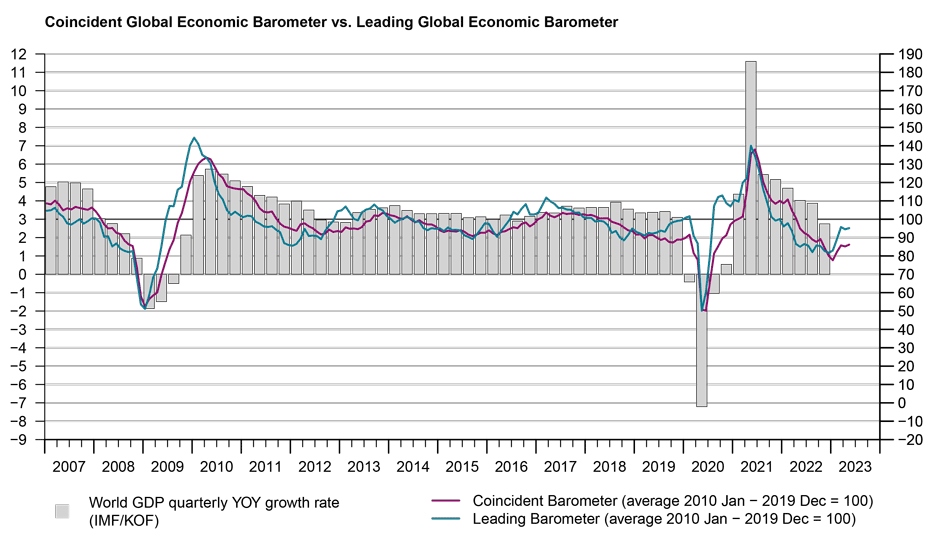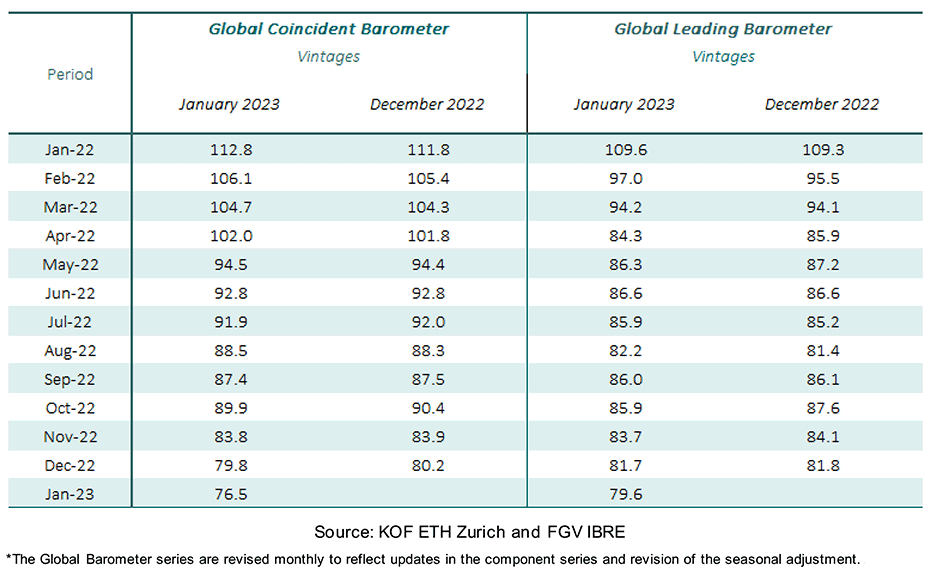Global Barometers continue to fall
The Global Barometers continue to signal a pronounced world economic slowdown at the beginning of 2023. Both indicators record a fall for the month and reach levels which – excluding the worst period of the COVID-19 crisis – have not been seen since 2009. The latest results are particularly depressed by developments of the indicators in the Asia, Pacific & Africa region.

In January 2023, the Coincident Global Economic Barometer falls 3.3 points to 76.5 points, the lowest level since July 2020 (68.5 points), while the Leading Global Economic Barometer drops 2.1 points to 79.6, the lowest level since June 2020 (59.6 points). With this result, the Coincident Barometer is below the level of the Leading Barometer for the second month in a row. The decrease in the two indicators was mainly caused by the worsening of the economic environment in the Asia, Pacific & Africa region, while the results for the other regions show a slight positive movement.
“The pandemic is still affecting the global economy. This time it seems to be the main cause for the deteriorated assessment of the current and expected situation in Asia. The Chinese government’s turnaround on its Covid strategy is leading to a weakening of the Chinese economy and increased uncertainty about economic developments in this region with spill-overs to the entire global economy”, evaluates Jan-Egbert Sturm, director of KOF Swiss Economic Institute.
“The pandemic is still affecting the global economy. The Chinese government’s turnaround on its Covid strategy is leading to a weakening of the Chinese economy and increased uncertainty about economic developments in this region with spill-overs to the entire global economy.”Jan-Egbert Sturm
Coincident Barometer – regions and sectors
In January, the Asia, Pacific & Africa region contributes negatively to the Coincident indicator with -3.6 points, while Europe and the Western Hemisphere contribute in the opposite direction with 0.2 and 0.1 points, respectively. The strong decrease in the Asia, Pacific & Africa region reflects the dramatic Covid-19 situation in China and its economic and social impacts. The continued low levels of the regional indicators constitute an adverse scenario for economic growth at the beginning of 2023. The graph below illustrates the contribution of each region to the deviation of the Coincident Barometer from the historical mean of 100 points.
Among the coincident sector indicators, Services, Industry, and the Economy (aggregated business and consumer evaluations) decrease this month, while Trade and Construction move in the opposite direction. All the sector indicators remain far from the historic mean of 100 points and suggest an economic slowdown spread across the sectors.
Leading Barometer – regions and sectors
The Leading Global Barometer leads the world economic growth rate cycle by three to six months on average. For the second consecutive month, only the Asia, Pacific & Africa region contributes negatively to the fall in the indicator, with -3.8 points. In contrast, the Western Hemisphere and Europe have gained 1.0 and 0.7 points, respectively. All levels of the indicators point to a continued scenario of pessimism for these economies for the coming months, with the Asia, Pacific & Africa region showing the lowest level among the regions, which has not occurred since June 2022.
Among the Leading indicator sectors, Industry, Trade, and Construction decrease in January, while the Economy and Services move in a positive direction. With this result the indicators also signal a pessimistic outlook for the coming months spread across the sectors.
The Global Economic Barometers
The Global Economic Barometers are a system of indicators enabling timely analysis of global economic development. They represent a collaboration between the KOF Swiss Economic Institute of the ETH Zurich in Switzerland and Fundação Getulio Vargas (FGV), based in Rio de Janeiro, Brazil. The system consists of two composite indicators, the Coincident Barometer and the Leading Barometer. The Coincident Barometer reflects the current state of economic activity, while the Leading Barometer provides a cyclical signal roughly six months ahead of current economic developments.
The two Barometers comprise the results of economic tendency surveys conducted in more than 50 countries with the aim of achieving the broadest possible global coverage. The advantages of economic tendency surveys are that their results are usually readily available and are not substantially revised after first publication.
The Coincident Barometer includes more than 1,000 different time series, while the Leading Barometer consists of over 600 time series. Cross-correlation analysis is used to decide which individual time series are included in the barometers. This involves correlating the individual time series with a reference series. The reference series used is the year-on-year growth rate of global gross domestic product (GDP), where the individual national GDPs are aggregated at purchasing power parity to form global GDP. A time series is only included in a Barometer if it shows a sufficiently high correlation and a suitable synchronization or lead with the reference series. The time period used for this correlation analysis currently runs from January 2010 to December 2019.
The series of the two Barometers are revised each month at publication and are standardized to have a mean of 100 and a standard deviation of 10 for the 10-year period previous to the most recent observations.
The methodology is described in:
Klaus Abberger, Michael Graff, Aloisio Jr. Campelo, Anna Carolina Lemos Gouveia, Oliver Müller and Jan-Egbert Sturm (2020), The Global Economic Barometers: Composite indicators for the world economy. KOF Working Papers, vol. 471, Zurich: KOF Swiss Economic Institute, ETH Zurich, 2020.
Contact
KOF Konjunkturforschungsstelle
Leonhardstrasse 21
8092
Zürich
Switzerland

